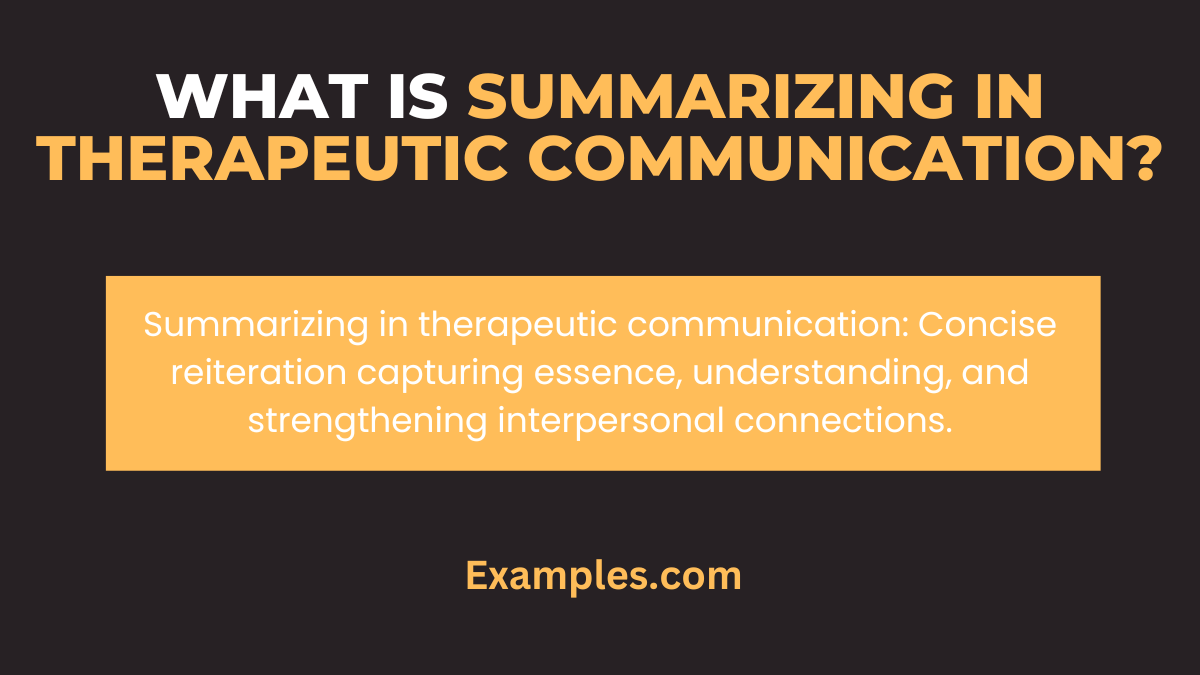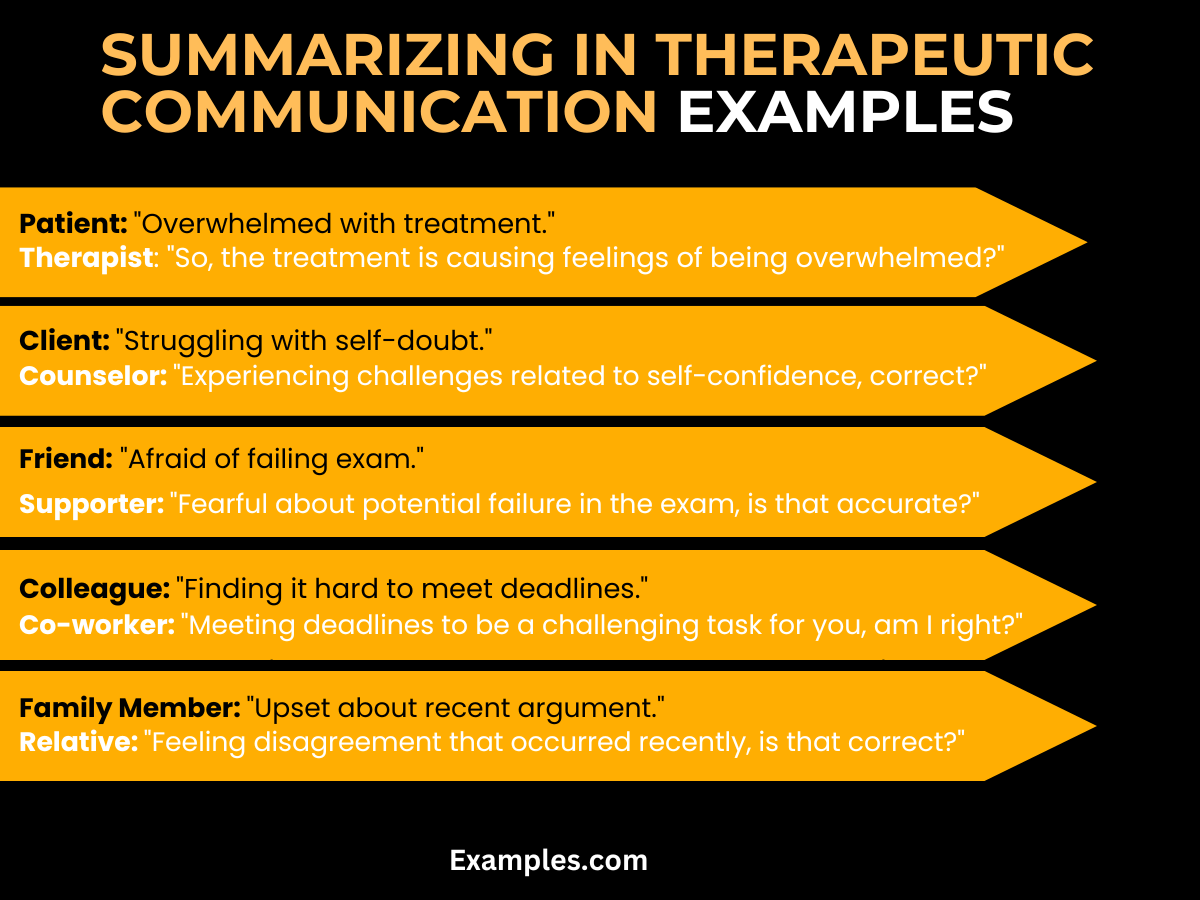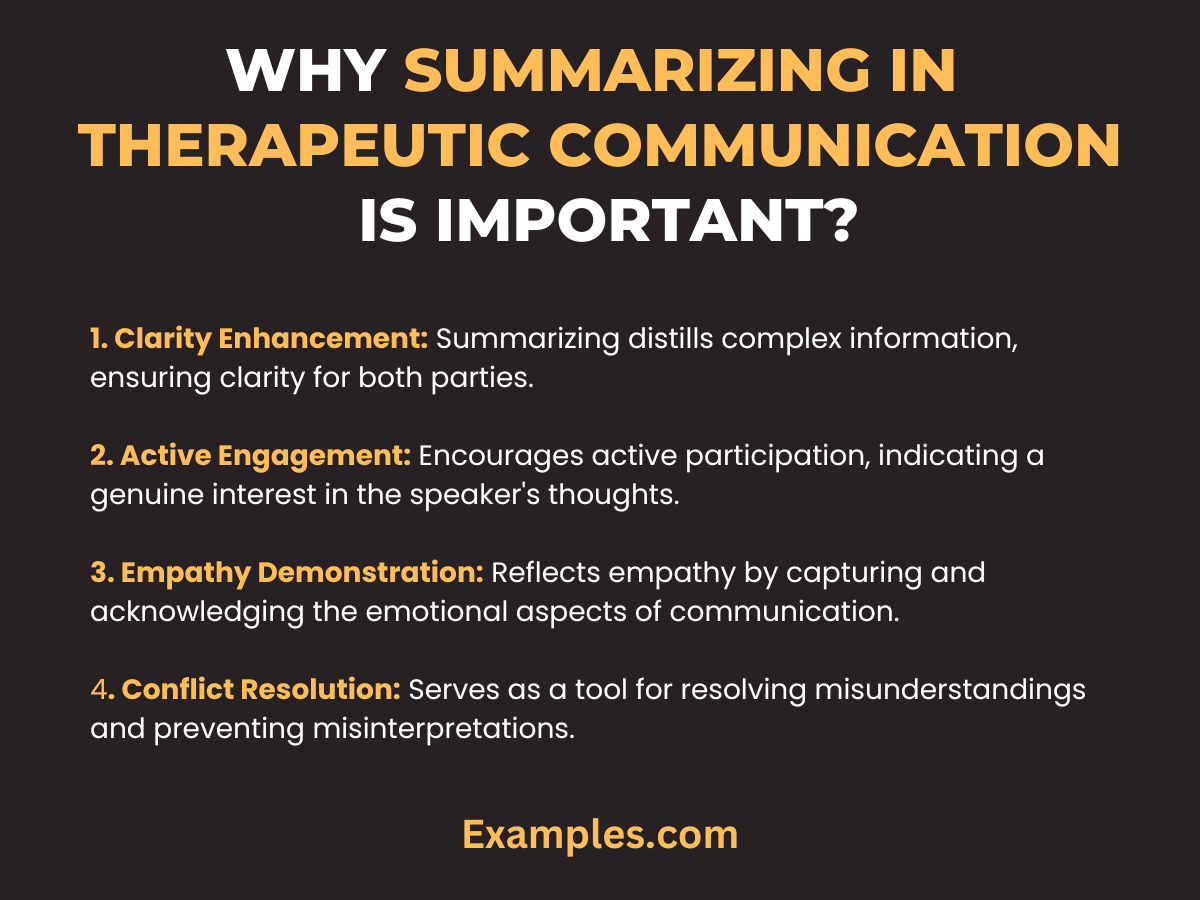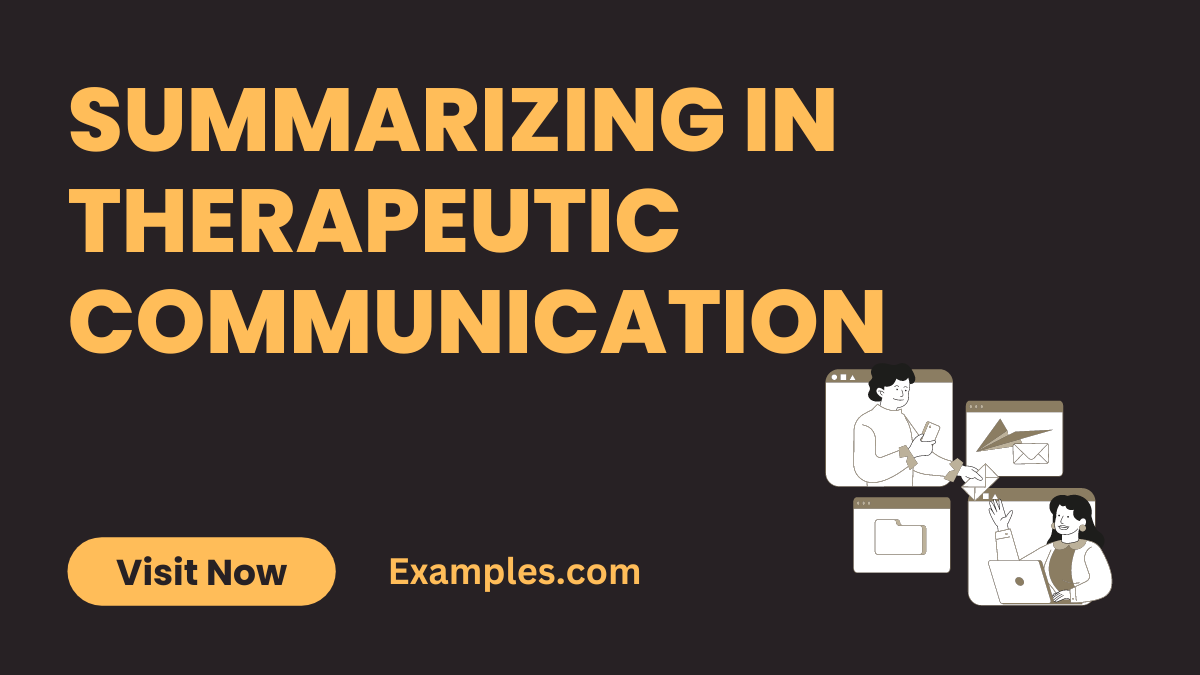19+ Summarizing in Therapeutic Communication Examples
Embark on a transformative journey with our comprehensive guide on “Summarizing in Therapeutic Communication.” Uncover the essence of effective summarizing techniques enriched with real-life communication examples. This guide illuminates the art of distilling complex dialogues, offering not just insights but practical applications. Elevate your therapeutic communication skills as we delve into the nuances of summarizing, providing you with the tools to navigate conversations with clarity and empathy.
What is Summarizing in Therapeutic Communication?

Summarizing in therapeutic communication is a crucial skill involving the concise reiteration of key points in a conversation. In simpler terms, it’s a method of condensing information to capture the essence of a discussion. This technique enhances understanding, ensures mutual clarity, and strengthens the therapeutic relationship by demonstrating active engagement. Summarizing serves as a valuable tool, fostering effective communication and promoting a shared understanding between individuals in a therapeutic setting.
20 Summarizing in Therapeutic Communication Examples

Unlock the power of succinct communication with our guide on Summarizing in Therapeutic Communication. This comprehensive resource not only introduces effective summarizing techniques but also provides vivid examples to enhance your grasp. Elevate your therapeutic conversations by mastering the art of summarization, fostering deeper connections and clearer understanding within various interpersonal interactions.
- Patient: “Overwhelmed with treatment.”
- Therapist: “So, the treatment is causing feelings of being overwhelmed?”
- Client: “Struggling with self-doubt.”
- Counselor: “Experiencing challenges related to self-confidence, correct?”
- Friend: “Afraid of failing exam.”
- Supporter: “Fearful about potential failure in the upcoming exam, is that accurate?”
- Colleague: “Finding it hard to meet deadlines.”
- Co-worker: “Meeting deadlines proving to be a challenging task for you, am I right?”
- Family Member: “Upset about recent argument.”
- Relative: “Feeling upset due to a disagreement that occurred recently, is that correct?”
- Student: “Anxious about presenting in class.”
- Classmate: “Experiencing anxiety in anticipation of a class presentation, is that accurate?”
- Employee: “Overwhelmed with workload pressure.”
- Manager: “Feeling overwhelmed due to the pressure of your workload, correct?”
- Client: “Don’t feel understood in therapy.”
- Therapist: “Experiencing a lack of understanding in our therapy sessions, is that accurate?”
- Teenager: “Parents don’t trust me.”
- Parent: “Sensing a lack of trust from your parents, is that right?”
- Patient: “Scared of upcoming procedure.”
- Medical Staff: “Experiencing fear in anticipation of the upcoming procedure, is that correct?”
- Friend: “Struggling with recent breakup.”
- Confidante: “Challenged by the recent breakup, am I understanding correctly?”
- Co-worker: “Frustrated with team dynamics.”
- Team Member: “Experiencing frustration due to challenges in team dynamics, is that right?”
- Family Member: “Feel distant from siblings.”
- Sibling: “Sensing a distance in your relationship with your siblings, am I understanding correctly?”
- Student: “Confused about assignment instructions.”
- Classmate: “Experiencing confusion regarding the instructions for the assignment, is that accurate?”
- Employee: “Not sure about role expectations.”
- Supervisor: “Uncertain about the expectations for your role, correct?”
- Client: “Don’t feel supported in goals.”
- Counselor: “Experiencing a lack of support in pursuing your goals, is that right?”
- Friend: “Feeling isolated lately.”
- Supportive Friend: “Sensing feelings of isolation lately, am I understanding correctly?”
- Patient: “Hesitant about trying new medication.”
- Healthcare Provider: “Experiencing hesitation about trying the new medication, is that accurate?”
- Teenager: “Opinions don’t matter at home.”
- Parent: “Feeling that your opinions aren’t valued at home, is that correct?”
- Employee: “Feel overlooked in team discussions.”
- Manager: “Sensing being overlooked in team discussions, am I understanding correctly?”
Summarizing in Therapeutic Communication Examples for Nursing Students
Navigate the nuances of therapeutic communication tailored for nursing students with our guide on Summarizing. This resource offers a tailored approach, providing unique examples to enhance comprehension. Elevate your nursing communication skills by mastering the art of summarization, ensuring clarity and empathy in various healthcare interactions.
- Nursing Student: “Overwhelmed with clinical rotations.”
- Instructor: “Feeling overwhelmed during clinical rotations, I understand.”
- Student Nurse: “Struggling with patient assessments.”
- Clinical Mentor: “Patient assessments proving challenging for you, correct?”
- Future Nurse: “Uncertain about medication administration.”
- Nursing Educator: “Feeling uncertain about medication administration, I acknowledge.”
- Nursing Learner: “Anxious about hands-on procedures.”
- Preceptor: “Hands-on procedures causing anxiety for you, I recognize.”
- Student in Healthcare: “Confused about interpreting lab results.”
- Clinical Instructor: “Interpreting lab results seems confusing; let’s go through it together.”
Summarizing in Therapeutic Communication Examples for Patients
Tailored for patients, this guide delves into the delicate art of summarizing in therapeutic communication within healthcare. Offering compassionate examples, it addresses unique emotional challenges faced during medical interactions. Learn how summarizing can provide comfort, clarity, and support in discussing complex medical information, fostering a connection that goes beyond clinical settings.
- Patient: “Overwhelmed by treatment options.”
- Healthcare Provider: “Feeling overwhelmed by treatment options; let’s simplify the choices.”
- Medical Patient: “Uncertain about post-surgery care.”
- Nurse: “Post-surgery care might seem uncertain; let’s discuss it step by step.”
- Individual with Health Concerns: “Confused about medication instructions.”
- Pharmacist: “Medication instructions causing confusion; let me clarify them for you.”
- Patient Undergoing Treatment: “Anxious about upcoming procedures.”
- Caregiver: “Feeling anxious about the upcoming procedures; we’ll ensure your comfort.”
- Healthcare Consumer: “Worried about long-term health impacts.”
- Medical Counselor: “Worries about long-term health impacts are valid; let’s address them together.”
Why Summarizing in Therapeutic Communication is Important?

Summarizing in therapeutic communication plays a pivotal role in fostering understanding and connection. Key points highlighting its importance include:
- Clarity Enhancement: Summarizing distills complex information, ensuring clarity for both parties.
- Active Engagement: Encourages active participation, indicating a genuine interest in the speaker’s thoughts.
- Empathy Demonstration: Reflects empathy by capturing and acknowledging the emotional aspects of communication.
- Conflict Resolution: Serves as a tool for resolving misunderstandings and preventing misinterpretations.
- Memory Reinforcement: Aids in memory reinforcement, helping individuals retain key information from the conversation.
- Enhanced Therapeutic Alliance: Strengthens the therapeutic relationship by creating a shared understanding.
- Individualized Communication: Allows tailoring of communication styles based on the unique needs of each individual.
- Facilitates Decision-Making: Supports informed decision-making by summarizing essential details.
- Promotes Patient Autonomy: Empowers patients to actively participate in their healthcare decisions.
What are Techniques for Summarizing in Therapeutic Communication?
Summarizing in therapeutic communication techniques is a nuanced skill crucial for effective interactions in healthcare settings. This technique involves the concise reiteration of key information, capturing the essence of a conversation while preserving its emotional nuances. Several techniques contribute to proficient summarization:
- Paraphrasing: Rephrasing the speaker’s words to confirm understanding without altering the meaning.
- Condensation: Succinctly summarizing lengthy information while retaining its essential elements.
- Reflection of Feelings: Articulating and validating the emotions expressed by the speaker.
- Clarification: Seeking additional information to ensure accurate summarization.
- Nonverbal Cues Observation: Paying attention to nonverbal cues for a more comprehensive understanding.
- Timely Summarization: Choosing opportune moments to summarize for maximum impact.
- Consistency in Tone: Aligning the summarization tone with the emotional context of the conversation.
- Tailoring to Audience: Adapting summarization techniques based on the unique needs and preferences of the audience.
- Avoiding Assumptions: Ensuring that the summary accurately reflects the speaker’s intended message.
How can Summarizing in Therapeutic Communication Techniques be helpful to Patients?
The application of summarizing techniques in therapeutic communication offers numerous benefits to patients, including:
- Clear Information Delivery: Patients receive information in a clear, concise manner, minimizing confusion.
- Empowerment: Summarizing empowers patients by involving them in the communication process.
- Emotional Validation: Acknowledging and summarizing emotions validates patients’ feelings and concerns.
- Enhanced Understanding: Patients gain a better understanding of their conditions, treatments, and care plans.
- Informed Decision-Making: Summarization aids patients in making informed decisions about their healthcare.
- Reduced Anxiety: Clear communication through summarizing can alleviate patient anxiety and uncertainty.
- Improved Recall: Summarized information is easier for patients to remember and recall.
- Therapeutic Rapport: Builds a positive therapeutic rapport, fostering a sense of trust and cooperation.
- Patient-Centered Care: Incorporates patients’ perspectives, contributing to a more patient-centered care approach.
In conclusion, mastering Summarizing in Therapeutic Communication is pivotal for effective healthcare interactions. This guide provides comprehensive techniques and real-world examples, empowering practitioners to enhance clarity and empathy. By honing these skills, professionals can navigate complex dialogues, strengthen therapeutic relationships, and contribute to positive patient experiences, ultimately fostering an environment of understanding, trust, and improved healthcare outcomes.



